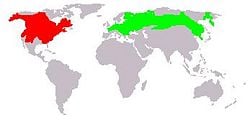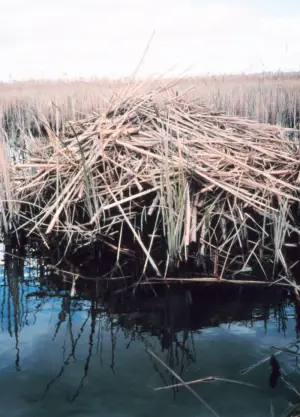Muskrat
| Muskrat
| ||||||||||||||||||||
|---|---|---|---|---|---|---|---|---|---|---|---|---|---|---|---|---|---|---|---|---|
 | ||||||||||||||||||||
| Scientific classification | ||||||||||||||||||||
| ||||||||||||||||||||
| Ondatra zibethicus (Linnaeus, 1766) | ||||||||||||||||||||
 Muskrat range (native range in red, introduced range in green)
I
|
The Muskrat or Musquash (Ondatra zibethicus), the only species in genus Ondatra, is a large aquatic rodent native to North America, and introduced in parts of Europe. It is nicknamed Swamp Bunny in the Mid-Atlantic States, especially in the marsh-lands and rivers surrounding the Chesapeake Bay. Adult body length is usually between 25-40 cm long, with a strong, laterally compressed tail 20-25 cm long. The body is covered in thick, brown waterproof fur; the underparts are paler. They have partially webbed hind feet and small able hand-like front feet. The weight is up to 1700 g, about four times the weight of a brown rat.
General introduction to muskrats
Muskrats are rats in the sense that they are medium sized rodents with a generalist lifestyle and an omnivorous diet. They are not, however, members of the genus Rattus, which includes the most well-known rats: The black rat (Rattus rattus) and the brown rat (Rattus norvegicus). Muskrats are members of the Muroidea superfamily, along with many other rodents including most mice and rats, and the Cricetidae family which includes hamsters, lemmings, pack rats, and many others.
The muskrat is one of the world's largest rats. It weighs from 700 to 1800 grams (1.5 to 4 lbs), about four times the size of the brown rat, which is the most common rat found as a city pest in North America and Europe and is also well-known as a pet and a laboratory animal. Muskrats are much smaller than beavers (Castor canadensis), with whom they share their habitat. Adult beavers weigh from 14,000 to 40,000 grams (30 to 88 lbs) (Nowak 1983).
The male muskrat marks his territory with a strong musky secretion which gives this animal its name. Females have 2 to 3 litters of 6 to 8 young. Muskrat populations appear to go through a regular pattern of rise and dramatic decline spread over a 6 to 10 year period.
The muskrats' aqautic life
Muskrats have two unique adaptations that help with survival. The first is the shape of their nostrils. They look like the numeral seven. The shape of the nostrils allows muskrats to inhale remaining oxygen from recently exhaled breath. This allows for muskrats to swim under water for up to 15 minutes. The other adaptation has to do with how the muskrat got its name. Muskrats are named because of the musk glands located near the underside of their tail. These secretions are used to warn other muskrats when a territory is already occupied. Keeping other muskrats away cuts down on competition for food and mates and aids in the muskrat's survival.
Muskrats live in wetlands: ponds, lakes, marshes and river banks, hence the nicknames "swamp bunny" or "water rat". They are very good swimmers, using their tail for propulsion in the water. Although they resemble beavers, they are much smaller and lack beavers' distinctive flat leathery tails, having instead thinner tails. They are found in Alaska, Canada, the United States and northern Mexico. Extensive burrow systems are dug in the ground adjacent to the water with an underwater entrance. In marshes, lodges are constructed from cattails and mud. They also build feeding platforms in wetlands. It is common to find Muskrats living in beaver lodges, too. Muskrats help maintain open areas in marshes, which helps to provide habitat for aquatic birds.
These animals are most active at night or near dawn and dusk. They feed on cattails and other aquatic vegetation, freshwater mussels, frogs, crayfish and small turtles. Their predators include mink, foxes, coyotes, wolves, lynx and large owls. They are also trapped for their fur and, in some communities, for their meat.
Muskrats and humans
While much wetland habitat has been eliminated due to human activity, new muskrat habitat has been created by the construction of canals or irrigation channels and the muskrat remains common and wide-spread.
They are able to live alongside streams which contain the sulphurous water that drains away from coal mines. Fish and frogs perish in such streams, yet muskrats may thrive and occupy the wetlands.
European countries such as Belgium and The Netherlands consider the muskrat to be a pest that must be exterminated. Therefore the animal is hunted to keep the population down. The muskrat is considered a pest because its burrowing causes damage to dykes and levees.
In Belgium and The Netherlands, killed animals are sometimes sold to restaurants and served as waterkonijn (water rabbit). In the Catholic Archdiocese of Detroit, there is a longstanding dispensation allowing Catholics to consume muskrat on Ash Wednesday and the Fridays of Lent (Lukowski 2007).
ReferencesISBN links support NWE through referral fees
- Attenborough, D. 2002. The Life of Mammals. Princeton, New Jersey: Princeton University Press. ISBN 0691113246
- Caras, R. 1967. North American Mammals. New York: Galahad Books. ISBN 088365072X
- Lukowski, K. 2007. "Muskrat love? It's a Lent thing for downriver area" The Official Web Site for the Archdiocese of Detroit. Accessed November 11, 2007.
- McMaster University (MU). 2007 The Muskrat Accessed November 11, 2007.
- Musgrave, P. 2007. "How the Muskrat Created the World" Muskrat.com Accessed November 11, 2007.
- Nowak, R. 1983. Walker's Mammals of the World. Baltimore, Maryland: The John Hopkins University Press. ISBN 0801825253
- Voelker, W. 1986. The Natural History of Living Mammals. Medford, New Jersey: Plexus Publishing, Inc. ISBN 0937548081
Credits
New World Encyclopedia writers and editors rewrote and completed the Wikipedia article in accordance with New World Encyclopedia standards. This article abides by terms of the Creative Commons CC-by-sa 3.0 License (CC-by-sa), which may be used and disseminated with proper attribution. Credit is due under the terms of this license that can reference both the New World Encyclopedia contributors and the selfless volunteer contributors of the Wikimedia Foundation. To cite this article click here for a list of acceptable citing formats.The history of earlier contributions by wikipedians is accessible to researchers here:
The history of this article since it was imported to New World Encyclopedia:
Note: Some restrictions may apply to use of individual images which are separately licensed.

